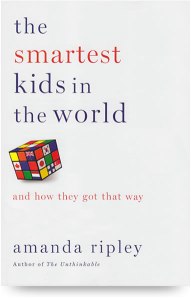 The premise of Amanda Ripley’s book, The Smartest Kids in the World, is the large gap in the 4-yearly PISA results between the USA and a number of Asian and European countries. As the PISA tests focus on skills such as problem solving and critical thinking, the results are extremely worrying for the USA. Ripley sets out to analyse education systems in 3 highly performing democracies, South Korea, Finland and Poland. She does this by following 3 American exchange students as they study one year in those countries.
The premise of Amanda Ripley’s book, The Smartest Kids in the World, is the large gap in the 4-yearly PISA results between the USA and a number of Asian and European countries. As the PISA tests focus on skills such as problem solving and critical thinking, the results are extremely worrying for the USA. Ripley sets out to analyse education systems in 3 highly performing democracies, South Korea, Finland and Poland. She does this by following 3 American exchange students as they study one year in those countries.
Education systems in those 3 countries are very different. South Korea’s success is to a large extent based on a very competitive and hierarchical system in which good marks at the graduation exam determine access to universities, which in turn determine job prospects. South Korean parents invest heavily in hagwons, private tutoring companies.
Interestingly, these three education systems share some elements as well:
- high selectivity in the entrance to the teaching profession;
- strong pre-service training, including long teaching practice;
- standardized testing upon graduation
- focus on learning in schools (vs. sports…)
- strong focus on equity, including investing more in those who need it and late tracking
- societal-wide focus on educational rigour
- large autonomy for teachers and schools
- high expectations for all learners.
Finland and Poland, and the turnaround they realized since the 1970s and 2000s respectively, get the most admiration.
“Interestingly, Finland’s landscape used to be littered with small teaching colleges of varying quality, just like in the United States. That helped explain why the first phase of reforms in Finland were painful, top-down, accountability-based measures. In the 1970s, Finnish teachers had to keep diaries recording what they taught each hour. National school inspectors made regular visits to make sure teachers were following an exhaustive, seven-hundred-page centralized curriculum. Central authorities approved textbooks. Teachers could not be trusted to make their own decisions.
Also, the Finns rebooted their teacher-training colleges, forcing them to become much more selective and rigorous. The Finns decided that the only way to get serious about education was to select highly educated teachers and train them rigorously.
With the new, higher standards and more rigorous teacher training in place, Finland’s top-down mandates became unnecessary. More than that, they became a burden, preventing teachers and schools from teaching a higher level of excellence. So Finland began dismantling its most oppressive regulations, piece by piece, as if removing the scaffolding from a fine sculpture.”
On the focus on equity in Finnish education:
“Equity was not just a matter of tracking and budgets, it was a mindset. Interestingly, this mindset extended to special education in Finland, too. Teachers considered most special ed students to have temporary learning difficulties, rather than permanent disabilities. By their seventeenth birthday, about half of Finnish kids has received some kind of special education services at some point, usually in elementary schools, so that they did not fall further behind.”
Despite the top scores in the PISA assessment, Koreans have been seeking to reform their education system since decades:
“The lesson seemed to be that without equity, the system would be gamed and distorted, Parental anxieties would lead to an education arms race. The rewards for an education had gotten too great and too rare in Korea, based on metrics that were too rigid.”
As long as students’ graduation scores determine the universities they can access and the name of the university determines the jobs that are attainable, parents will do whatever it takes to ensure the best possible outcome for their children.
However, the Korean education system offers some lessons on how parents can effectively support their offspring:
During the 1980s and 1990s, American parents and teachers had been bombarded by claims that children’s self-esteem needed to be protected from competition (and reality) in order for them to succeed. So, it was understandable that American parents dutifully sold cupcakes at the bake sales and helped coach the soccer teams. They doled out praise and trophies at a rate unmatched in other countries. They were their kids’ boosters, their number-one fans. Korean parents, by contrast, were coaches. They spent less time attending school events and more time training their children at home. They saw education as one of their jobs.Contrary to the stereotype, it did not necessarily make children miserable.”
“That’s what gimmicks do: they promise to make learning easy for everyone. Can’t learn math? It’s because your learning style hasn’t been identified. Trouble with Spanish? This new app will make it fun and effortless.”However, that kind of relentless studying could not be sustained, and there was evidence that Korean kids’ famous drive dropped off dramatically once they got to college.”
“We were trying the reverse engineer a high-performance teaching culture through dazzlingly complex performance evaluations and value-added data analysis. It made sense to reward, train and dismiss more teachers based on their performance, but that approach assumed that the worst teachers would be replaced with much better ones, and that the mediocre teachers would improve enough to give students the kind of education they deserved. There was not much evidence that either scenario was happening in reality.”